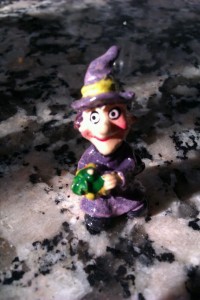Were you king or “tontolaba”? Spanish traditions in “el Día de Reyes” Posted by Magda on Jan 10, 2013 in Spanish Culture
¡Hola a todos, y bienvenidos a este flamante año nuevo!
Como posiblemente sabéis, la Navidad dura un poquito más en algunos países, así que apenas estamos volviendo a nuestra rutina. Nuestro último día de vacaciones fue el 6 de Enero, la Epifanía, cuando celebramos la visita de los Tres Reyes Magos al niño Jesús. Es durante la noche anterior que estos magos nos dejan algunos regalos, si hemos sido buenos a lo largo del año, o un puñado de carbón si no lo hemos sido.
Una de nuestras tradiciones para este día es compartir con nuestra familia y amigos el roscón de Reyes: es un dulce que esconde una baratija, una pequeña figurita religiosa y un haba. Si encuentras la figura en tu trozo del pastel, serás coronado por un día y tendrás por delante un año lleno de buena suerte. Si encuentras el haba, tendrás que pagar el siguiente roscón.
Así que estaba yo buscando la figurita (porque obviamente no quería pagar el roscón del año que viene) cuando de repente otra persona la encontró, y no era un rey o una imagen de la Virgen, ¡sino una pequeña bruja para nuestra sorpresa! Y esto me hizo preguntarme sobre el origen de este postre.
Se remonta a tiempos romanos y sus fiestas Saturnales, cuando incluso los esclavos eran eximidos de trabajar, y se divertían como hombres libres. La gente solía comer un pastel hecho con miel y frutos secos, y ya que el haba era símbolo de prosperidad y fertilidad, lo escondían en el pastel como regalo sorpresa. Esta celebración pagana desapareció, pero no así el pastel, que adoptó la forma de roscón con que la conocemos hoy.
La aristocracia francesa adoraba este postre, e introdujeron un regalo más valioso (una moneda de oro en ocasiones), que se transformó en una figurita tiempo después. Así que hoy día el afortunado que encuentra el regalo es “el rey de la fiesta”, y quien encuentra el haba paga y recibe el mote de “tontolaba” (que proviene de “tonto del haba”). Curioso ¿verdad?
image by moverelbigote
Hi everybody, and welcome to this brand new year!
As you probably know, Christmas lasts a bit more in some countries, so we are nearly returning to routine by now. Our last holiday was January the 6th, the Epiphany, when we celebrate the visit of the Three Wise Men to Jesus child. It is the night before that these magic men leave us some gifts, if we have been good during the year or some coal if we have not.
One of our traditions in this day is to share with our family and friends the King cake: it is a cake containing a trinket, a small religious figure and a broad bean. If you find the figure in your piece of cake, you will be “crowned” for a day and have a year full of good luck ahead. If you find the broad bean, you will have to pay for the next cake.
So I was looking for my little figure (because obviously I didn’t want to pay next year’s cake) when suddenly somebody else found it, and it was not a King of Virgin Mary image, but a little witch to our surprise! That made me wonder about the origin of this dessert.
It goes back to Roman times and their Saturnalia festivities, when even slaves were excused from working and enjoyed themselves as free men. People used to eat a cake made of honey and some nuts, and as the broad bean was a symbol of prosperity and fertility, it was hidden in the cake as a kind of surprise gift. The pagan celebration was lost, but not the cake, which adopted the doughnut form we know today.
The French aristocracy loved the dessert, and they introduced a more valuable present (a golden coin sometimes), which changed into the small figure later on. So now the fortunate person who gets the gift is the “king of the feast”, and the one who finds the broad bean pays and receives the nickname of “tontolaba” (“tonto del haba”, the silly of the broad bean). Funny, isn’t it?

Build vocabulary, practice pronunciation, and more with Transparent Language Online. Available anytime, anywhere, on any device.



